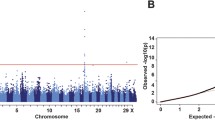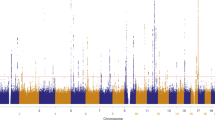Abstract
Cutaneous melanoma arises from transformed melanocytes and is caused mainly by environmental effects such as ultraviolet radiation and to a lesser extent by predisposing genetic variants. Only a few susceptibility genes for cutaneous melanoma have been identified so far in human; therefore, animal models represent a valuable alternative for genetic studies of this disease. In a previous quantitative trait locus (QTL) study, several susceptibility regions were identified in a swine biomedical model, the MeLiM (Melanoblastoma-bearing Libechov minipig) pigs. This article details the fine-mapping of a QTL located on SSC13 (Sus scrofa chromosome 13) through an increase in marker density. New microsatellites were used to confirm the results of the first analysis, and MITF (microphthalmia-associated transcription factor) was selected as a candidate gene for melanoma development. A single-marker association analysis was performed with single-nucleotide polymorphisms (SNPs) spread over the locus, but it did not reveal a significant association with diverse melanoma-related traits. In parallel, MITF alternative transcripts were characterized and their expression was investigated in different porcine tissues. The obtained results showed a complex transcriptional regulation concordant with the one present in other mammals. Notably, the ratio between MITF+ and MITF− isoforms in melanoma samples followed the same pattern as in human tumors, which highlights the adequacy of the MeLiM pig as a model for human melanoma. In conclusion, although MITF does not seem to be the causal gene of the QTL initially observed, we do not exclude a prominent role of its transcription and function in the outbreak and evolution of the tumors observed in pigs.




Similar content being viewed by others

References
Bharti K, Liu W, Csermely T, Bertuzzi S, Arnheiter H (2008) Alternative promoter use in eye development: the complex role and regulation of the transcription factor MITF. Development 135:1169–1178
Bidanel JP, Milan D, Iannuccelli N, Amigues Y, Boscher MY, Bourgeois F, Caritez JC, Gruand J, Le Roy P, Lagant H, Quintanilla R, Renard C, Gellin J, Ollivier L, Chevalet C (2001) Detection of quantitative trait loci for growth and fatness in pigs. Genet Sel Evol 33:289–309
Bishop DT, Demenais F, Iles MM, Harland M, Taylor JC, Corda E, Randerson-Moor J, Aitken JF, Avril MF, Azizi E, Bakker B, Bianchi-Scarra G, Bressac-de Paillerets B, Calista D, Cannon-Albright LA, Chin AWT, Debniak T, Galore-Haskel G, Ghiorzo P, Gut I, Hansson J, Hocevar M, Hoiom V, Hopper JL, Ingvar C, Kanetsky PA, Kefford RF, Landi MT, Lang J, Lubinski J, Mackie R, Malvehy J, Mann GJ, Martin NG, Montgomery GW, van Nieuwpoort FA, Novakovic S, Olsson H, Puig S, Weiss M, van Workum W, Zelenika D, Brown KM, Goldstein AM, Gillanders EM, Boland A, Galan P, Elder DE, Gruis NA, Hayward NK, Lathrop GM, Barrett JH, Bishop JA (2009) Genome-wide association study identifies three loci associated with melanoma risk. Nat Genet 41:920–925
Bismuth K, Maric D, Arnheiter H (2005) MITF and cell proliferation: the role of alternative splice forms. Pigment Cell Res 18:349–359
Box NF, Duffy DL, Chen W, Stark M, Martin NG, Sturm RA, Hayward NK (2001) MC1R genotype modifies risk of melanoma in families segregating CDKN2A mutations. Am J Hum Genet 69:765–773
Chaudru V, Laud K, Avril MF, Miniere A, Chompret A, Bressac-de Paillerets B, Demenais F (2005) Melanocortin-1 receptor (MC1R) gene variants and dysplastic nevi modify penetrance of CDKN2A mutations in French melanoma-prone pedigrees. Cancer Epidemiol Biomarkers Prev 14:2384–2390
Cronin JC, Wunderlich J, Loftus SK, Prickett TD, Wei X, Ridd K, Vemula S, Burrell AS, Agrawal NS, Lin JC, Banister CE, Buckhaults P, Rosenberg SA, Bastian BC, Pavan WJ, Samuels Y (2009) Frequent mutations in the MITF pathway in melanoma. Pigment Cell Melanoma Res 22:435–444
Demenais F, Mohamdi H, Chaudru V, Goldstein AM, Newton Bishop JA, Bishop DT, Kanetsky PA, Hayward NK, Gillanders E, Elder DE, Avril MF, Azizi E, van Belle P, Bergman W, Bianchi-Scarra G, Bressac-de Paillerets B, Calista D, Carrera C, Hansson J, Harland M, Hogg D, Hoiom V, Holland EA, Ingvar C, Landi MT, Lang JM, Mackie RM, Mann GJ, Ming ME, Njauw CJ, Olsson H, Palmer J, Pastorino L, Puig S, Randerson-Moor J, Stark M, Tsao H, Tucker MA, van der Velden P, Yang XR, Gruis N (2010) Association of MC1R variants and host phenotypes with melanoma risk in CDKN2A mutation carriers: a GenoMEL study. J Natl Cancer Inst 102:1568–1583
Du ZQ, Vincent-Naulleau S, Gilbert H, Vignoles F, Crechet F, Shimogiri T, Yasue H, Leplat JJ, Bouet S, Gruand J, Horak V, Milan D, Le Roy P, Geffrotin C (2007) Detection of novel quantitative trait loci for cutaneous melanoma by genome-wide scan in the MeLiM swine model. Int J Cancer 120:303–320
Falchi M, Bataille V, Hayward NK, Duffy DL, Bishop JA, Pastinen T, Cervino A, Zhao ZZ, Deloukas P, Soranzo N, Elder DE, Barrett JH, Martin NG, Bishop DT, Montgomery GW, Spector TD (2009) Genome-wide association study identifies variants at 9p21 and 22q13 associated with development of cutaneous nevi. Nat Genet 41:915–919
Fuse N, Yasumoto K, Suzuki H, Takahashi K, Shibahara S (1996) Identification of a melanocyte-type promoter of the microphthalmia-associated transcription factor gene. Biochem Biophys Res Commun 219:702–707
Garraway LA, Widlund HR, Rubin MA, Getz G, Berger AJ, Ramaswamy S, Beroukhim R, Milner DA, Granter SR, Du J, Lee C, Wagner SN, Li C, Golub TR, Rimm DL, Meyerson ML, Fisher DE, Sellers WR (2005) Integrative genomic analyses identify MITF as a lineage survival oncogene amplified in malignant melanoma. Nature 436:117–122
Gilbert H, Le Roy P (2007) Methods for the detection of multiple linked QTL applied to a mixture of full and half sib families. Genet Sel Evol 39:139–158
Giuliano S, Cheli Y, Ohanna M, Bonet C, Beuret L, Bille K, Loubat A, Hofman V, Hofman P, Ponzio G, Bahadoran P, Ballotti R, Bertolotto C (2010) Microphthalmia-associated transcription factor controls the DNA damage response and a lineage-specific senescence program in melanomas. Cancer Res 70:3813–3822
Haley CS, Knott SA, Elsen JM (1994) Mapping quantitative trait loci in crosses between outbred lines using least squares. Genetics 136:1195–1207
Hemesath TJ, Steingrimsson E, McGill G, Hansen MJ, Vaught J, Hodgkinson CA, Arnheiter H, Copeland NG, Jenkins NA, Fisher DE (1994) Microphthalmia, a critical factor in melanocyte development, defines a discrete transcription factor family. Genes Dev 8:2770–2780
Hershey CL, Fisher DE (2005) Genomic analysis of the Microphthalmia locus and identification of the MITF-J/Mitf-J isoform. Gene 347:73–82
Hussussian CJ, Struewing JP, Goldstein AM, Higgins PA, Ally DS, Sheahan MD, Clark WH Jr, Tucker MA, Dracopoli NC (1994) Germline p16 mutations in familial melanoma. Nat Genet 8:15–21
Julé S, Bossé P, Egidy G, Panthier JJ (2003) Establishment and characterization of a normal melanocyte cell line derived from pig skin. Pigment Cell Res 16:407–410
Kamb A, Shattuck-Eidens D, Eeles R, Liu Q, Gruis NA, Ding W, Hussey C, Tran T, Miki Y, Weaver-Feldhaus J et al (1994) Analysis of the p16 gene (CDKN2) as a candidate for the chromosome 9p melanoma susceptibility locus. Nat Genet 8:23–26
Levy C, Khaled M, Fisher DE (2006) MITF: master regulator of melanocyte development and melanoma oncogene. Trends Mol Med 12:406–414
Levy C, Khaled M, Robinson KC, Veguilla RA, Chen PH, Yokoyama S, Makino E, Lu J, Larue L, Beermann F, Chin L, Bosenberg M, Song JS, Fisher DE (2010) Lineage-specific transcriptional regulation of DICER by MITF in melanocytes. Cell 141:994–1005
Miller AJ, Levy C, Davis IJ, Razin E, Fisher DE (2005) Sumoylation of MITF and its related family members TFE3 and TFEB. J Biol Chem 280:146–155
Molina DM, Grewal S, Bardwell L (2005) Characterization of an ERK-binding domain in microphthalmia-associated transcription factor and differential inhibition of ERK2-mediated substrate phosphorylation. J Biol Chem 280:42051–42060
Murakami M, Iwata Y, Funaba M (2007) Expression and transcriptional activity of alternative splice variants of MITF exon 6. Mol Cell Biochem 303:251–257
O’Connell JR, Weeks DE (1998) PedCheck: a program for identification of genotype incompatibilities in linkage analysis. Am J Hum Genet 63:259–266
Perez-Enciso M, Misztal I (2004) Qxpak: a versatile mixed model application for genetical genomics and QTL analyses. Bioinformatics 20:2792–2798
Primot A, Mogha A, Corre S, Roberts K, Debbache J, Adamski H, Dreno B, Khammari A, Lesimple T, Mereau A, Goding CR, Galibert MD (2010) ERK-regulated differential expression of the Mitf 6a/b splicing isoforms in melanoma. Pigment Cell Melanoma Res 23:93–102
Rambow F, Piton G, Bouet S, Leplat JJ, Baulande S, Marrau A, Stam M, Horak V, Vincent-Naulleau S (2008) Gene expression signature for spontaneous cancer regression in melanoma pigs. Neoplasia 10:714–726
Rozen S, Skaletsky H (2000) Primer3 on the WWW for general users and for biologist programmers. Methods Mol Biol 132:365–386
Selzer E, Wacheck V, Lucas T, Heere-Ress E, Wu M, Weilbaecher KN, Schlegel W, Valent P, Wrba F, Pehamberger H, Fisher D, Jansen B (2002) The melanocyte-specific isoform of the microphthalmia transcription factor affects the phenotype of human melanoma. Cancer Res 62:2098–2103
Soufir N, Avril MF, Chompret A, Demenais F, Bombled J, Spatz A, Stoppa-Lyonnet D, Benard J, Bressac-de Paillerets B (1998) Prevalence of p16 and CDK4 germline mutations in 48 melanoma-prone families in France. The French Familial Melanoma Study Group. Hum Mol Genet 7:209–216
Steingrimsson E, Moore KJ, Lamoreux ML, Ferre-D’Amare AR, Burley SK, Zimring DC, Skow LC, Hodgkinson CA, Arnheiter H, Copeland NG et al (1994) Molecular basis of mouse microphthalmia (mi) mutations helps explain their developmental and phenotypic consequences. Nat Genet 8:256–263
Takeda K, Yasumoto K, Kawaguchi N, Udono T, Watanabe K, Saito H, Takahashi K, Noda M, Shibahara S (2002) Mitf-D, a newly identified isoform, expressed in the retinal pigment epithelium and monocyte-lineage cells affected by MITF mutations. Biochim Biophys Acta 1574:15–23
Takemoto CM, Yoon YJ, Fisher DE (2002) The identification and functional characterization of a novel mast cell isoform of the microphthalmia-associated transcription factor. J Biol Chem 277:30244–30252
Tshori S, Sonnenblick A, Yannay-Cohen N, Kay G, Nechushtan H, Razin E (2007) Microphthalmia transcription factor isoforms in mast cells and the heart. Mol Cell Biol 27:3911–3919
Tsuchida S, Takizawa T, Abe K, Okamoto M, Tagawa M (2009) Identification of microphthalmia-associated transcription factor isoforms in dogs. Vet J 182:283–293
Vachtenheim J, Novotna H (1999) Expression of genes for microphthalmia isoforms, Pax3 and MSG1, in human melanomas. Cell Mol Biol (Noisy-le-grand) 45:1075–1082
Vincent-Naulleau S, Le Chalony C, Leplat JJ, Bouet S, Bailly C, Spatz A, Vielh P, Avril MF, Tricaud Y, Gruand J, Horak V, Frelat G, Geffrotin C (2004) Clinical and histopathological characterization of cutaneous melanomas in the melanoblastoma-bearing Libechov minipig model. Pigment Cell Res 17:24–35
Zuo L, Weger J, Yang Q, Goldstein AM, Tucker MA, Walker GJ, Hayward N, Dracopoli NC (1996) Germline mutations in the p16INK4a binding domain of CDK4 in familial melanoma. Nat Genet 12:97–99
Acknowledgments
This work was funded by La Ligue Nationale Contre le Cancer, in the framework of the projects of Genetic Epidemiology 2006–2008 and 2010–2011. ZQD was a postdoctoral fellow from INRA Animal Genetics Department and JE was a postdoctoral fellow from the INRA program “Jeunes Docteurs.” The authors are thankful to several people for microsatellite genotyping: Catherine Denis at UMR GABI, Micaëlla Germain at Labogena, and Julie Mautord at Plateforme Génomique in Toulouse. The authors also acknowledge Diana Zelenika for SNP genotyping organization and Patrice Dehais for providing SNP information.
Author information
Authors and Affiliations
Corresponding author
Additional information
Nucleotide sequence data reported are available in the GenBank database under accession numbers GU097381, GU097382, and GU097383.
Electronic supplementary material
Below is the link to the electronic supplementary material.
Rights and permissions
About this article
Cite this article
Bourneuf, E., Du, ZQ., Estellé, J. et al. Genetic and functional evaluation of MITF as a candidate gene for cutaneous melanoma predisposition in pigs. Mamm Genome 22, 602–612 (2011). https://doi.org/10.1007/s00335-011-9334-6
Received:
Accepted:
Published:
Issue Date:
DOI: https://doi.org/10.1007/s00335-011-9334-6



